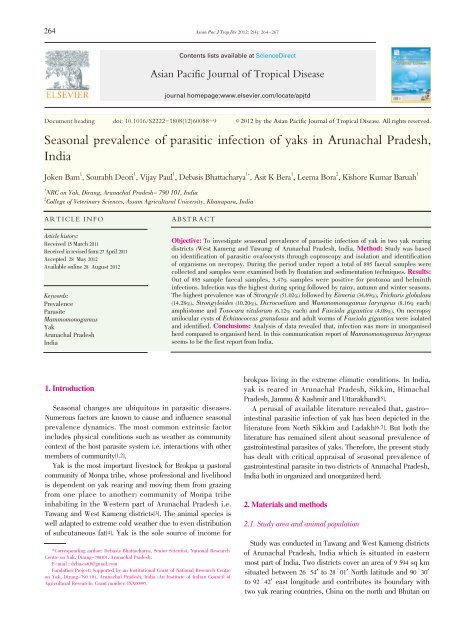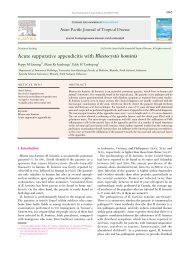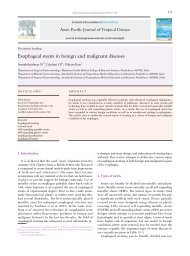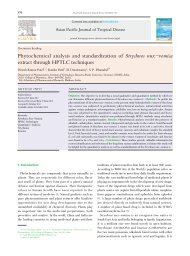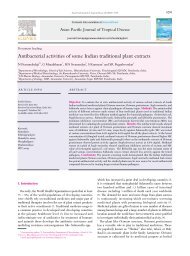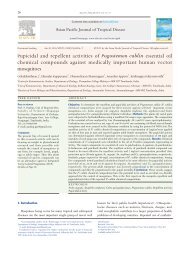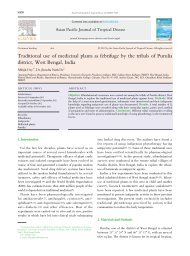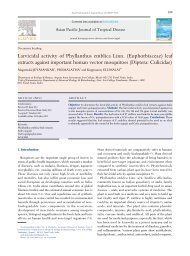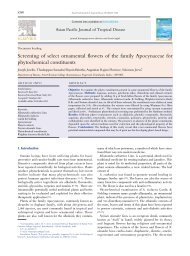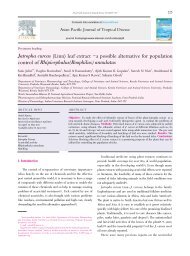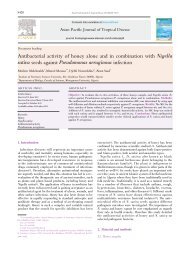Seasonal prevalence of parasitic infection of yaks in Arunachal ...
Seasonal prevalence of parasitic infection of yaks in Arunachal ...
Seasonal prevalence of parasitic infection of yaks in Arunachal ...
You also want an ePaper? Increase the reach of your titles
YUMPU automatically turns print PDFs into web optimized ePapers that Google loves.
264<br />
Asian Pac J Trop Dis 2012; 2(4): 264-267<br />
Asian Pacific Journal <strong>of</strong> Tropical Disease<br />
journal homepage:www.elsevier.com/locate/apjtd<br />
Document head<strong>in</strong>g doi: 10.1016/S2222-1808(12)60058-9 襃 2012 by the Asian Pacific Journal <strong>of</strong> Tropical Disease. All rights reserved.<br />
<strong>Seasonal</strong> <strong>prevalence</strong> <strong>of</strong> <strong>parasitic</strong> <strong><strong>in</strong>fection</strong> <strong>of</strong> <strong>yaks</strong> <strong>in</strong> <strong>Arunachal</strong> Pradesh,<br />
India<br />
Joken Bam 1 , Sourabh Deori 1 , Vijay Paul 1 , Debasis Bhattacharya 1* , Asit K Bera 1 , Leema Bora 2 , Kishore Kumar Baruah 1<br />
1 NRC on Yak, Dirang, <strong>Arunachal</strong> Pradesh- 790 101, India<br />
2 College <strong>of</strong> Veter<strong>in</strong>ary Sciences, Assam Agricultural University, Khanapara, India<br />
ARTICLE INFO ABSTRACT<br />
Article history:<br />
Received 15 March 2011<br />
Received <strong>in</strong> revised form 27 April 2011<br />
Accepted 28 May 2012<br />
Available onl<strong>in</strong>e 28 August 2012<br />
Keywords:<br />
Prevalence<br />
Parasite<br />
Mammomonogamus<br />
Yak<br />
<strong>Arunachal</strong> Pradesh<br />
India<br />
1. Introduction<br />
<strong>Seasonal</strong> changes are ubiquitous <strong>in</strong> <strong>parasitic</strong> diseases.<br />
Numerous factors are known to cause and <strong>in</strong>fluence seasonal<br />
<strong>prevalence</strong> dynamics. The most common extr<strong>in</strong>sic factor<br />
<strong>in</strong>cludes physical conditions such as weather as community<br />
context <strong>of</strong> the host parasite system i.e. <strong>in</strong>teractions with other<br />
members <strong>of</strong> community[1,2].<br />
Yak is the most important livestock for Brokpa (a pastoral<br />
community <strong>of</strong> Monpa tribe, whose pr<strong>of</strong>essional and livelihood<br />
is dependent on yak rear<strong>in</strong>g and mov<strong>in</strong>g them from graz<strong>in</strong>g<br />
from one place to another) community <strong>of</strong> Monpa tribe<br />
<strong>in</strong>habit<strong>in</strong>g <strong>in</strong> the Western part <strong>of</strong> <strong>Arunachal</strong> Pradesh i.e.<br />
Tawang and West Kameng districts[3]. The animal species is<br />
well adapted to extreme cold weather due to even distribution<br />
<strong>of</strong> subcutaneous fat[4]. Yak is the sole source <strong>of</strong> <strong>in</strong>come for<br />
*Correspond<strong>in</strong>g author: Debasis Bhattacharya, Senior Scientist, National Research<br />
Centre on Yak, Dirang-790101, <strong>Arunachal</strong> Pradesh.<br />
E-mail : debasis63@gmail.com<br />
Fundation Project: Supported by an Institutional Grant <strong>of</strong> National Research Centre<br />
on Yak, Dirang-790 101, <strong>Arunachal</strong> Pradesh, India (An Institute <strong>of</strong> Indian Council <strong>of</strong><br />
Agricultural Research). Grant number: IXX00997.<br />
Contents lists available at ScienceDirect<br />
Objective: To <strong>in</strong>vestigate seasonal <strong>prevalence</strong> <strong>of</strong> <strong>parasitic</strong> <strong><strong>in</strong>fection</strong> <strong>of</strong> yak <strong>in</strong> two yak rear<strong>in</strong>g<br />
districts (West Kameng and Tawang) <strong>of</strong> <strong>Arunachal</strong> Pradesh, India. Method: Study was based<br />
on identification <strong>of</strong> <strong>parasitic</strong> ova/oocysts through coproscopy and isolation and identification<br />
<strong>of</strong> organisms on necropsy. Dur<strong>in</strong>g the period under report a total <strong>of</strong> 895 faecal samples were<br />
collected and samples were exam<strong>in</strong>ed both by floatation and sedimentation techniques. Results:<br />
Out <strong>of</strong> 895 sample faecal samples, 5.47% samples were positive for protozoa and helm<strong>in</strong>th<br />
<strong><strong>in</strong>fection</strong>s. Infection was the highest dur<strong>in</strong>g spr<strong>in</strong>g followed by ra<strong>in</strong>y, autumn and w<strong>in</strong>ter seasons.<br />
The highest <strong>prevalence</strong> was <strong>of</strong> Strongyle (51.02%) followed by Eimeria (34.69%), Trichuris globulosa<br />
(14.28%), Strongyloides (10.20%), Dicrocoelium and Mammomonogamus laryngeus (8.16% each)<br />
amphistome and Toxocara vitulorum (6.12% each) and Fasciola gigantica (4.08%). On necropsy<br />
unilocular cysts <strong>of</strong> Ech<strong>in</strong>ococcus granulosus and adult worms <strong>of</strong> Fasciola gigantica were isolated<br />
and identified. Conclusions: Analysis <strong>of</strong> data revealed that, <strong><strong>in</strong>fection</strong> was more <strong>in</strong> unorganised<br />
herd compared to organised herd. In this communication report <strong>of</strong> Mammomonogamus laryngeus<br />
seems to be the first report from India.<br />
brokpas liv<strong>in</strong>g <strong>in</strong> the extreme climatic conditions. In India,<br />
yak is reared <strong>in</strong> <strong>Arunachal</strong> Pradesh, Sikkim, Himachal<br />
Pradesh, Jammu & Kashmir and Uttarakhand[5].<br />
A perusal <strong>of</strong> available literature revealed that, gastro<strong>in</strong>test<strong>in</strong>al<br />
<strong>parasitic</strong> <strong><strong>in</strong>fection</strong> <strong>of</strong> yak has been depicted <strong>in</strong> the<br />
literature from North Sikkim and Ladakh[6,7]. But both the<br />
literature has rema<strong>in</strong>ed silent about seasonal <strong>prevalence</strong> <strong>of</strong><br />
gastro<strong>in</strong>test<strong>in</strong>al parasites <strong>of</strong> <strong>yaks</strong>. Therefore, the present study<br />
has dealt with critical appraisal <strong>of</strong> seasonal <strong>prevalence</strong> <strong>of</strong><br />
gastro<strong>in</strong>test<strong>in</strong>al parasite <strong>in</strong> two districts <strong>of</strong> <strong>Arunachal</strong> Pradesh,<br />
India both <strong>in</strong> organized and unorganized herd.<br />
2. Materials and methods<br />
2.1. Study area and animal population<br />
Study was conducted <strong>in</strong> Tawang and West Kameng districts<br />
<strong>of</strong> <strong>Arunachal</strong> Pradesh, India which is situated <strong>in</strong> eastern<br />
most part <strong>of</strong> India. Two districts cover an area <strong>of</strong> 9 594 sq km<br />
situated between 26 坐 54’ to 28 坐 01’ North latitude and 90 坐 30’<br />
to 92 坐 42’ east longitude and contributes its boundary with<br />
two yak rear<strong>in</strong>g countries, Ch<strong>in</strong>a on the north and Bhutan on
the West. <strong>Arunachal</strong> Pradesh is a generally hilly region. The<br />
elevation <strong>of</strong> the hills ranges from 60 metres to over 7 300 metres<br />
(GORICHEN peak <strong>in</strong> West Kameng). The territory falls <strong>in</strong> outer<br />
Himalayas and Patkoi ranges[8]. The seasons and ra<strong>in</strong>fall <strong>in</strong><br />
<strong>Arunachal</strong> Pradesh is divided <strong>in</strong>to four seasons i.e. w<strong>in</strong>ter<br />
(December to February), spr<strong>in</strong>g (March to May), ra<strong>in</strong>y (June to<br />
August) and autumn (September to November). The number <strong>of</strong><br />
<strong>yaks</strong> <strong>in</strong> Tawang and West Kameng districts are 7 132 and 803,<br />
respectively[9].<br />
2.2. Collection and process<strong>in</strong>g <strong>of</strong> samples<br />
Samples were collected dur<strong>in</strong>g 2010-2011 dur<strong>in</strong>g all the four<br />
seasons.<br />
2.2.1. Collection <strong>of</strong> faecal samples<br />
Dur<strong>in</strong>g the period <strong>of</strong> study a total <strong>of</strong> 895 samples were<br />
collected either from the rectum or freshly voided faeces<br />
were taken <strong>in</strong>to consideration. Out <strong>of</strong> 895 samples, 650 and<br />
245 samples were collected from West Kameng and Tawang<br />
districts, respectively. Samples were brought to the laboratory<br />
ma<strong>in</strong>ta<strong>in</strong><strong>in</strong>g cold cha<strong>in</strong>. The samples were exam<strong>in</strong>ed both by<br />
floatation and sedimentation techniques.<br />
2.2.2 Collection <strong>of</strong> samples dur<strong>in</strong>g necropsy<br />
Dur<strong>in</strong>g the period under report(2010-2011) post mortem<br />
exam<strong>in</strong>ation <strong>of</strong> 71 <strong>yaks</strong> were carried out. The samples were<br />
exam<strong>in</strong>ed for parasites. The abomasum, small and large<br />
<strong>in</strong>test<strong>in</strong>es were exam<strong>in</strong>ed thoroughly for parasites. In brief,<br />
aforesaid morbid materials were placed <strong>in</strong>dividually <strong>in</strong>to<br />
a separate tray. Each segment was opened and washed<br />
thoroughly <strong>in</strong> phosphate buffer sal<strong>in</strong>e (PBS) (pH7.2) and<br />
exam<strong>in</strong>ed under a microscope. Parasites were collected,<br />
preserved and cleaned <strong>in</strong> lactophenol and exam<strong>in</strong>ed<br />
microscopically for identification.<br />
Table 3<br />
Parasite wise seasonal <strong>prevalence</strong> <strong>in</strong> yak <strong>of</strong> <strong>Arunachal</strong> Pradesh (n=49).<br />
Joken Bam et al./Asian Pac J Trop Dis 2012; 2(4): 264-267 265<br />
3. Results<br />
Out <strong>of</strong> 895 samples, 49 samples(5.47%) were positive for<br />
protozoa and helm<strong>in</strong>th <strong><strong>in</strong>fection</strong>s. Presences <strong>of</strong> parasite ova<br />
or oocysts <strong>in</strong> the faecal samples were recorded and <strong><strong>in</strong>fection</strong><br />
was the highest (13.91%) <strong>in</strong> the spr<strong>in</strong>g followed by ra<strong>in</strong>y (8.23%),<br />
autumn (3.50%) and w<strong>in</strong>ter seasons (1.42%). <strong>Seasonal</strong> <strong>prevalence</strong><br />
<strong>of</strong> <strong>parasitic</strong> <strong><strong>in</strong>fection</strong> along with their sample size has been<br />
depicted <strong>in</strong> Table 1.<br />
Table 1<br />
Season wise <strong>prevalence</strong> <strong>of</strong> parasites <strong>in</strong> yak <strong>of</strong> <strong>Arunachal</strong> Pradesh.<br />
Season No. <strong>of</strong> samples No. positive<br />
W<strong>in</strong>ter (December to February) 280 4 (1.42%)<br />
Spr<strong>in</strong>g (March to May) 115 16 (13.91%)<br />
Ra<strong>in</strong>y (June to August) 243 20 (8.23%)<br />
Autumn (September to November) 257 9 (3.50%)<br />
Total 895 49 (5.47%)<br />
Subsequently this was found that, out <strong>of</strong> 650 samples<br />
collected from West Kameng district 5.69% animals were found<br />
positive for gastro<strong>in</strong>test<strong>in</strong>al parasites. A total <strong>of</strong> 4.89% yak were<br />
found positive on coproscopy when samples collected from<br />
Tawang were analysed <strong>in</strong> the laboratory. The details district<br />
wise seasonal <strong>prevalence</strong> <strong>of</strong> gastro<strong>in</strong>test<strong>in</strong>al parasites <strong>in</strong> two<br />
districts <strong>of</strong> <strong>Arunachal</strong> Pradesh has been depicted <strong>in</strong> Table 2.<br />
Table 2<br />
District wise seasonal <strong>prevalence</strong> <strong>of</strong> parasites <strong>in</strong> yak.<br />
Season West Kameng Tawang<br />
No. <strong>of</strong> no.<strong>of</strong> positive (%) No. <strong>of</strong> no. <strong>of</strong> positive (%)<br />
samples<br />
samples<br />
W<strong>in</strong>ter 229 4 (1.74%) 51 0<br />
Spr<strong>in</strong>g 92 13 (14.13%) 23 3 (13.04%)<br />
Ra<strong>in</strong>y 147 13 (8.84%) 96 7 (7.29%)<br />
Autumn 182 7 (3.84%) 75 2 (2.66%)<br />
Total 650 37 (5.69%) 245 12 (4.89%)<br />
Further analysis <strong>of</strong> data revealed that, the highest <strong>prevalence</strong><br />
was <strong>of</strong> Strongyle (51.02%) followed by Eimeria (34.69%), Trichuris<br />
Parasite species W<strong>in</strong>ter Spr<strong>in</strong>g Ra<strong>in</strong>y Autumn Total Area<br />
Strongyle 2 12 5 6 25 (51.02%) West Kameng<br />
Eimeria 2 2 12 1 17 (34.69%) West Kameng, Tawang<br />
Trichuris globulosa - 5 1 1 7 (14.28%) West Kameng<br />
Strongyloides - 4 1 - 5 (10.20%) West Kameng<br />
Dicrocoelium - - 4 - 4 (8.16%) West Kameng, Tawang<br />
Mammomonogamus<br />
laryngeus<br />
- 3 1 - 4 (8.16%) West Kameng<br />
Toxocara vitulorum - - 2 - 3 (6.12%) West Kameng, Tawang<br />
Amphistome - 1 2 - 3 (6.12%) West Kameng<br />
Fasciola gigantica - 1 0 1 2 (4.08%) West Kameng<br />
Table 4<br />
<strong>Seasonal</strong> <strong>prevalence</strong> <strong>of</strong> <strong>parasitic</strong> fauna <strong>in</strong> organized and unorganized herds.<br />
Location W<strong>in</strong>ter Spr<strong>in</strong>g Ra<strong>in</strong>y Autumn Total<br />
Organised farm 1/152 (0.66%) 1/51 (1.96%) 9/150 (6.00%) 1/153 (0.65%) 12/506 (2.37%)<br />
Unorganized farm 3/128 (2.34%) 15/64 (23.43%) 11/93 (11.82%) 8/104 (7.69%) 37/389 (9.51%)<br />
Total 4/280 (1.42%) 16 /115 (13.91%) 20/243 (8.23%) 9/257 (3.50%) 49/895 (5.47%)
266<br />
globulosa (14.28%), Strongyloides (10.20%), Dicrocoelium &<br />
Mammomonogamus laryngeus (8.16% each), amphistome<br />
& Toxocara vitulorum (6.12% each) and Fasciola gigantica<br />
(4.08%). <strong>Seasonal</strong> <strong>prevalence</strong> <strong>of</strong> different genera and species <strong>of</strong><br />
parasites has been detailed through Table 3.<br />
This has been also revealed that, <strong><strong>in</strong>fection</strong> was more <strong>in</strong><br />
unorganised farm compared to organised farm. The details<br />
seasonal <strong>prevalence</strong> <strong>of</strong> parasites <strong>in</strong> organised and unorganised<br />
farm has been depicted <strong>in</strong> Table 4.<br />
After conduct<strong>in</strong>g necropsy <strong>in</strong> organised farm this has been<br />
revealed that, out <strong>of</strong> 48 animals, three female animals were<br />
positive for Toxocara vitulorum and Fasciola gigantica. On<br />
the contrary <strong>yaks</strong> reared under traditional system by Monpa<br />
tribe, Hamonchus contortus was isolated from abomasum,<br />
Trichostrongylus, Nematodirus and Trichuris were identified<br />
Joken Bam et al./Asian Pac J Trop Dis 2012; 2(4): 264-267<br />
Figure 1. Isolated organisms dur<strong>in</strong>g necropsy <strong>of</strong> <strong>yaks</strong>.<br />
a) Germ<strong>in</strong>al membrane <strong>of</strong> hydatid cyst, b) Trichuris spp., c) Fasciola, d) Toxocara vitulorum.<br />
4. Discussion<br />
For centuries, the yak and their hybrids (dzomo/dzo) have<br />
been contribut<strong>in</strong>g to the socioeconomic status <strong>of</strong> their owners<br />
<strong>in</strong> two districts (Tawang and West Kameng) <strong>of</strong> <strong>Arunachal</strong><br />
Pradesh. So far <strong>parasitic</strong> diseases <strong>of</strong> yak is concerned,<br />
helm<strong>in</strong>th <strong><strong>in</strong>fection</strong>s has been reported from time to time by<br />
different group <strong>of</strong> workers. In general the major risk factors<br />
<strong>of</strong> helm<strong>in</strong>thosis can broadly classified as <strong>parasitic</strong> factors<br />
(<strong>in</strong>clud<strong>in</strong>g epidemiology <strong>of</strong> the different species), host factors<br />
(genetic resistance, age and physiological status <strong>of</strong> the animals)<br />
and environmental factors (climate, nutrition, stock<strong>in</strong>g density<br />
and management)[10].<br />
<strong>in</strong> the <strong>in</strong>test<strong>in</strong>e and Fasciola gigantica was isolated from<br />
the liver. After exam<strong>in</strong>ation <strong>of</strong> lungs, unilocular cysts <strong>of</strong><br />
Ech<strong>in</strong>ococcus granulosus and Fasciola gigantica were isolated<br />
and identified from liver <strong>of</strong> dead animals (Table 5, Figure 1).<br />
Table 5<br />
Helm<strong>in</strong>th parasites recovered from yak at necropsy.<br />
Yak reared <strong>in</strong> No. No. Parasites recovered<br />
different system Exam<strong>in</strong>ed Positive<br />
Organised farm Toxocara vitulorum and<br />
Male 36 - Fasciola<br />
Female 12 3<br />
Yak reared <strong>in</strong><br />
Trichuris, Fasciola,<br />
Traditional system<br />
Haemonchus, Nematodirus,<br />
Male 15 11 Trichostrongylus, Hydatid<br />
Female 8 4 cyst<br />
Dur<strong>in</strong>g the present endeavour <strong>parasitic</strong> and environmental<br />
factors have been taken <strong>in</strong>to consideration s<strong>in</strong>ce critical<br />
appraisal <strong>of</strong> seasonal <strong>prevalence</strong> <strong>of</strong> the parasite has been<br />
taken <strong>in</strong>to consideration for the first time from <strong>Arunachal</strong><br />
Pradesh, India systematically. Although <strong>in</strong>itial signature on<br />
gastro<strong>in</strong>test<strong>in</strong>al parasites have <strong>in</strong>dicated helm<strong>in</strong>th <strong><strong>in</strong>fection</strong>s<br />
<strong>in</strong> yak <strong>of</strong> <strong>Arunachal</strong> Pradesh but the study has not <strong>in</strong>dicated<br />
about necropsy f<strong>in</strong>d<strong>in</strong>g[11]. S<strong>in</strong>ce <strong>of</strong> late Bandyopadhyay et<br />
al[6] have reported gastro<strong>in</strong>test<strong>in</strong>al helm<strong>in</strong>ths <strong>in</strong> <strong>yaks</strong> reared<br />
<strong>in</strong> Sikkim both <strong>in</strong> organised and traditionally managed <strong>yaks</strong>.<br />
But <strong>in</strong> their study they have only screened <strong>parasitic</strong> <strong><strong>in</strong>fection</strong><br />
through coproscopy. But present endeavour has dealt with both<br />
coprological exam<strong>in</strong>ation and necropsy f<strong>in</strong>d<strong>in</strong>g. On the contrary<br />
a perusal <strong>of</strong> available literature revealed that, systematic
study on parasites <strong>of</strong> yak has been conducted <strong>in</strong> Ladakh<br />
(Jammu & Kashmir), Sikkim and villages near the Indo-Nepal<br />
border <strong>of</strong> Uttar Pradesh. The authors reported gastro<strong>in</strong>test<strong>in</strong>al<br />
protozoa, nematodes, trematodes, cestodes and metacestodes<br />
(Coenurus spp. and Ech<strong>in</strong>ococcus granulosus) but they could<br />
not found any haemoprotista <strong>of</strong> pathogenic importance[7]. Our<br />
f<strong>in</strong>d<strong>in</strong>g also corroborates with the f<strong>in</strong>d<strong>in</strong>g <strong>of</strong> RangaRao et al[7]<br />
because dur<strong>in</strong>g the present endeavour we have identified<br />
gastro<strong>in</strong>test<strong>in</strong>al helm<strong>in</strong>ths and protozoa. Besides by necropsy<br />
we have isolated metacestodes <strong>of</strong> zoonotic importance and liver<br />
fluke <strong><strong>in</strong>fection</strong>. Moreover, identification <strong>of</strong> Mammomonogamus<br />
largeus <strong>in</strong> 8.16% yak seems to be the first report from India.<br />
Likewise metacestodes <strong>of</strong> zoonotic importance has been also<br />
reported earlier from Sikkim[12] which also affirms with our<br />
present f<strong>in</strong>d<strong>in</strong>g.<br />
Besides report on <strong>parasitic</strong> diseases <strong>of</strong> yak with<strong>in</strong> political<br />
boundary <strong>of</strong> India, <strong>parasitic</strong> <strong><strong>in</strong>fection</strong> <strong>of</strong> yak has been reported<br />
from Bhutan, Nepal and PR Ch<strong>in</strong>a. Coneurosis has been<br />
reported as an important <strong>parasitic</strong> <strong><strong>in</strong>fection</strong>[13]. But we could<br />
not report this organism s<strong>in</strong>ce we have not exam<strong>in</strong>ed the<br />
bra<strong>in</strong> tissue. Like our f<strong>in</strong>d<strong>in</strong>g on hydatidosis, this tapeworm<br />
has been also reported from Nepal[14]. Like hydatidosis, high<br />
<strong>prevalence</strong> <strong>of</strong> fascioliasis has been reported from PR Ch<strong>in</strong>a<br />
and Nepal dur<strong>in</strong>g 90’s and also <strong>in</strong> this century[15-18]. Dur<strong>in</strong>g<br />
our present <strong>in</strong>vestigation we could also f<strong>in</strong>d Fasciola (4.08%)<br />
and other fluke resid<strong>in</strong>g <strong>in</strong> the liver (Dicrocoelium dendrticum).<br />
But both Indian and foreign literature have rema<strong>in</strong>ed silent<br />
about the latter organism. This particular f<strong>in</strong>d<strong>in</strong>g suggests that,<br />
hepatic disorder <strong>in</strong> yak may occur due to both Fasciola and<br />
Dicrocoelium <strong>of</strong> yak <strong>in</strong> <strong>Arunachal</strong> Pradesh. Likewise, round<br />
worm has been reported from Ch<strong>in</strong>a[16,17,19] and Bhutan[20].<br />
Consider<strong>in</strong>g the present scenario <strong>of</strong> <strong>parasitic</strong> <strong><strong>in</strong>fection</strong> <strong>in</strong><br />
yak this may be concluded that, yak <strong>in</strong> <strong>Arunachal</strong> Pradesh<br />
suffers from mixed <strong>parasitic</strong> <strong><strong>in</strong>fection</strong> <strong>of</strong> both veter<strong>in</strong>ary and<br />
zoonotic importance which demands <strong>in</strong>tervention through<br />
chemotherapy, pasture management and control <strong>of</strong> <strong>parasitic</strong><br />
<strong><strong>in</strong>fection</strong> <strong>of</strong> can<strong>in</strong>e.<br />
Conflict <strong>of</strong> <strong>in</strong>terest statement<br />
We declare that we have no conflict <strong>of</strong> <strong>in</strong>terest.<br />
References<br />
[1] Johnson PTJ, Parberg D, Taylor PA, Halloran GM. Long term<br />
disease dynamics <strong>in</strong> lakes: causes and consequences <strong>of</strong><br />
chytrid <strong><strong>in</strong>fection</strong>s <strong>in</strong> Daphnia population. Ecolology 2009; 90:<br />
132-144.<br />
[2] Baoag B. Observations on the seasonal <strong>in</strong>cidence <strong>of</strong><br />
myxomatosis and its <strong>in</strong>teractions with helm<strong>in</strong>th parasites <strong>in</strong><br />
the European rabbit (Oryctolagus cuniculus). J Wildlife Dis<br />
1988; 24: 450-455.<br />
[3] Till<strong>in</strong>g T, Longjam N, Perme B. Protozoan diseases <strong>of</strong> livestock<br />
<strong>in</strong> <strong>Arunachal</strong> Pradesh-An Overview. Vet World 2011; 4:<br />
332-336.<br />
[4] Orskov ER. Some physical, physiological and biochemical<br />
Joken Bam et al./Asian Pac J Trop Dis 2012; 2(4): 264-267 267<br />
adaptations <strong>of</strong> rum<strong>in</strong>ant livestock <strong>in</strong>clud<strong>in</strong>g buffaloes to<br />
different feeds and climates. Italian J Anim Sci 2007; 6:<br />
223-226.<br />
[5] Pal RN, Barari SK, Biswas D. Yak Husbandry <strong>in</strong> India. Asian<br />
Livestock 1994; 10: 126-128.<br />
[6] Bandyophadyay S, Pal S, Bhattacharya D, Bera AK, Pan D,<br />
Rahman H. A report on the <strong>prevalence</strong> <strong>of</strong> gastro<strong>in</strong>test<strong>in</strong>al<br />
parasites <strong>in</strong> <strong>yaks</strong> (Bos poephagus) <strong>in</strong> the cold desert <strong>of</strong> North<br />
Sikkim, India. Trop Anim Hlth Prod 2010; 42: 119-121.<br />
[7] RangaRao GSC, Sharma RL, Hemapresanth. Parasitic<br />
<strong><strong>in</strong>fection</strong>s <strong>of</strong> Indian yak Bos (Poephagus) grunniens-an<br />
overview. Vet Parasitol 1994; 53: 75-82.<br />
[8] Horticulture. [Onl<strong>in</strong>e] Available from: www.arunachalpradesh.<br />
nic.<strong>in</strong><br />
[9] Government <strong>of</strong> <strong>Arunachal</strong> Pradesh. State report on 18th<br />
qu<strong>in</strong>quenneial <strong>in</strong> livestock census. Nirjuli, India: Government<br />
<strong>of</strong> <strong>Arunachal</strong> Pradesh, Department <strong>of</strong> Animal Husbandry and<br />
Veter<strong>in</strong>ary; 2007, p. 25&115.<br />
[10] Odoi A, Gathuma JM, Gachuiri CK, Omore A. Risk factors<br />
<strong>of</strong> gastro<strong>in</strong>test<strong>in</strong>al nematode parasite <strong><strong>in</strong>fection</strong>s <strong>in</strong> small<br />
rum<strong>in</strong>ants kept <strong>in</strong> smallholder mixed farms <strong>in</strong> Kenya. BMC<br />
Vet Res 2007; 3: 6. doi 10.1186/1746-6148-3-6.<br />
[11] Dorji T, Roder W, Yu S. 9 diseases <strong>of</strong> yak. In: The yak. RAP<br />
Publication; 2002, p. 121-132.<br />
[12] Ansari MZ, Rai MK. Studies on occurrence and <strong>in</strong>cidence<br />
<strong>of</strong> hydatid disease <strong>in</strong> yak <strong>in</strong> Sikkim. Indian Vet J 1991; 68:<br />
112-114.<br />
[13] Samdrup T. Gid surveillance <strong>in</strong> yak under L<strong>in</strong>gshe dungkhagtour<br />
report. Parasitology Unit, RVEC, Thimpu, Bhutan; 1992,<br />
p.130.<br />
[14] Joshi DD, Lensch J, Sasaki M, Hentsch G. Epidemiological<br />
aspects <strong>of</strong> yak diseases <strong>in</strong> Nepal. In: Proceed<strong>in</strong>gs <strong>of</strong> the<br />
Second International congress on yak, X<strong>in</strong><strong>in</strong>g, Ch<strong>in</strong>a, 1-6<br />
September, 1997. X<strong>in</strong><strong>in</strong>g, Ch<strong>in</strong>a, Q<strong>in</strong>ghai People’s Publish<strong>in</strong>g<br />
House; 1997, p. 229-233.<br />
[15] Lensch J. Krankheiten: In Der Yak (Bos grunniens). In:<br />
Lensch J, Schley P, Zhang RC. Zentralasian. Duncker &<br />
Humblot, Berl<strong>in</strong>; 1996, p. 237-246.<br />
[16] Yunfei Y, Hongn<strong>in</strong>g W, Guangyon Y, Guangrong L, B<strong>in</strong>g T.<br />
Epidemiological survey and control method <strong>of</strong> enterozoic<br />
disease <strong>of</strong> yak and Tibetan sheep <strong>in</strong> the Sichuan West-North<br />
grasslands. In: Proceed<strong>in</strong>gs <strong>of</strong> the International Congress on<br />
Yak, Chengdu, Sichuan, P.R Ch<strong>in</strong>a; 2004.<br />
[17] Hogg K. Internal parasites <strong>of</strong> yak (Bos grunniens) <strong>of</strong> the<br />
Gannan, Gansu Prov<strong>in</strong>ce, P.R. Ch<strong>in</strong>a. In: Proceed<strong>in</strong>gs <strong>of</strong> the<br />
International Congress on Yak, Chengdu, Sichuan, P.R. Ch<strong>in</strong>a;<br />
2004.<br />
[18] Joshi DD. Yak and chauri Husbandry <strong>in</strong> Nepal. S<strong>in</strong>gha: H.M.<br />
Government Press; 1982.<br />
[19] L<strong>in</strong> WD. Observations on growth decl<strong>in</strong>e rule <strong>of</strong> roundworm<br />
and its larva <strong>in</strong> yak’s stomach and <strong>in</strong>test<strong>in</strong>e. In: Proceed<strong>in</strong>gs<br />
<strong>of</strong> the first International Congress on Yak. J Gansu Agril Univ;<br />
1994. 339-342.<br />
[20] Wangdi P. Survey <strong>of</strong> gid eradication program: <strong>in</strong>cidence <strong>of</strong><br />
Coenurosis <strong>in</strong> yak population at L<strong>in</strong>gshu dungkahg. Yak<br />
Newsletter 1996; 2: 12-24.


